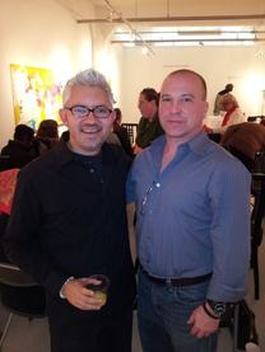 Sergio Gomez and Jordan Scott at 33 Contemporary Gallery, Chicago, 2014 Sergio Gomez and Jordan Scott at 33 Contemporary Gallery, Chicago, 2014 I had the pleasure to be interviewed recently by the great artist, gallerist, curator and educator, Sergio Gomez. Please see the following link to see the entire interview with images: In Synch Interview of Jordan Scott In Sych with Jordan Scott In this blog post, I have the pleasure of interviewing a wonderful Chicago artist whose works are currently on view at Judy A Saslow Gallery. He is a dedicated and talented artists whose work you should know about. Check out the interview and get In-Sync with Jordan Scott. SG: Where did you go to school & what was your area of concentration? JS: I graduated from Indiana University (Bloomington). I have a degree in Religious Studies/Philosophy. The Religious Studies program was an intensive writing program mixed with religion, history and philosophy. I have always been interested in philosophy and religious ideas, particularly of East Asia, including India, China and Japan. Many of these ideas and beliefs, mainly the notion of a universal “connection” (i.e. Jungian idea of a collective consciousness), are still a major theme in my artwork today. I am also currently enrolled in the digital photography program at the Chicago Photography Academy. I have always been interested in photography and I am excited to see how photography continues to work its way into my art in the future. SG: What is your website? JS: My website is: www.jordanscottart.com SG: What are you working on and what inspires you right now? JS: I am currently working on an ongoing series of geometric abstractions using thousands of used postage stamps and resin as my medium. I have been working on this series for about ten years now. In my studio, the essential things I cannot live without are my Keurig coffee and tea maker and my adjustable wall easel system that I designed and built myself. SG: Do you find social media to be a distraction or an asset for you as an artist and how do you deal with it? JS: Presently, the only social media I am using is Facebook and it took me a while to get used to and appreciate it. It has definitely become an asset. I schedule time each day to check in with posts and at least once a week submit my own posts to my art page and to several groups. If used correctly and in balance, Facebook is a great resource and platform. I will be adding Instagram to the mix soon at the advice of a fellow artist friend. SG: What is your biggest challenge as a contemporary artist? JS: My biggest challenge as a contemporary artist is balancing my studio time (i.e. creating) with the back office time (i.e. PR and marketing/submitting, etc.). I am constantly struggling with spending enough time on the later of the two. In other words, I am too heavy on the studio side and too light on the back office side. SG: What’s next for you (exhibits, projects, travels, residencies, etc)? JS: I currently have as show up at Judy A Saslow Gallery in Chicago, and will be a part of a show at the Christopher Art Center in Chicago Heights in February. Later in the year, I will have new work at Roan and Black Gallery in Suagatuck, Michigan, and Wright Gallery in Northport, Michigan. SG: Do you believe gallery representation today is as important as it has been in the past? JS: I have always had gallery representation and have a good experience with that avenue and the exposure it brings. I know several artists who are doing quite well with no, or little, gallery representation. It’s exciting to see the changes in the entire model of being an artist and selling artwork. I think gallery representation is still important, but there are so many other avenues now as well, especially for the artist who deals in reproductions and smaller works. SG: What is one word of advice you would give to emerging artists? JS: My personal advice to other artists is to participate in as many workshops and groups as possible, and these days with webinar format, it is easier than ever. Sergio’s “Next Level” workshop and Paul Klein’s “Klein Artist Works” are good examples and are both highly recommended by me. Also, it is very important that an artist is proficient with both a digital camera and Photoshop (or Lightroom, or similar programs). It is an absolute must to be able to document one’s own work on a regular basis, not once a quarter in a professional photographer’s studio. My studio, in the Cornelia Art Building, is organized so that I can set up my lights and camera and shoot within 15-20 minutes at any time. It is important for an artist to understand proper exposure and white balance and how to use lighting. And then a good working knowledge of post-production in Photoshop is a must. I can’t tell you how many times I have seen the images an artist submitted to a gallery or show and I was stunned. They didn’t even crop out the surroundings in the dining room they shot it in! |
Archives
July 2024
|
jordandscoTT[@]sbcglobal.net | 773-206-2824 | Chicago IL USA

